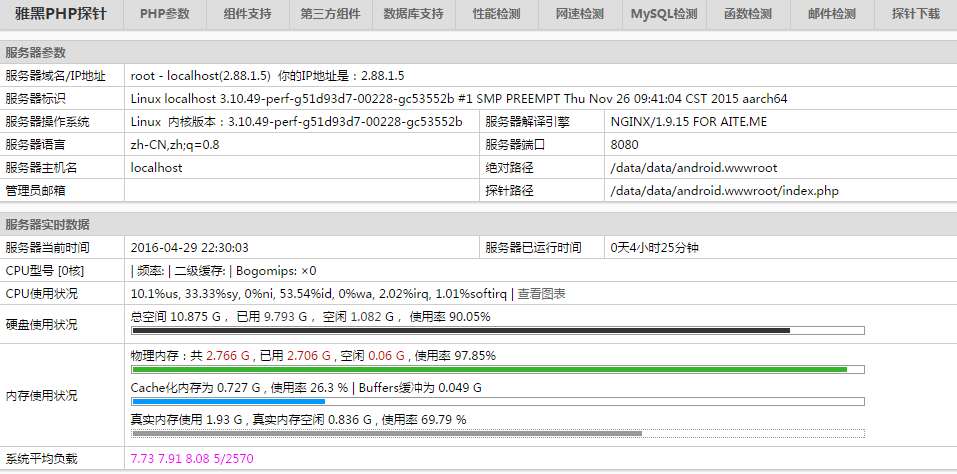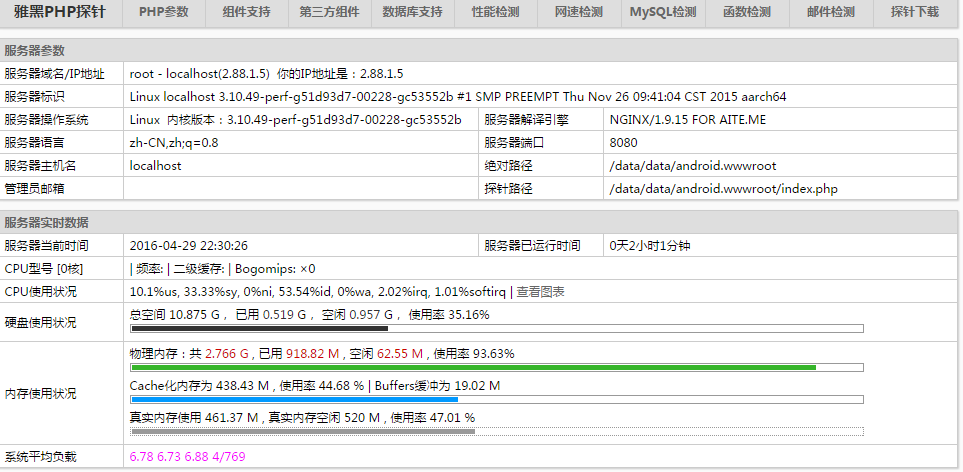昨晚研究了一晚,现在用一个效率更高的方案:直接在安卓系统上运行而不chroot到linux镜像下。
安卓已经有人做好一个集成环境了:https://sourceforge.net/projects/anmpp/
论坛链接:http://webthen.net/forum-36-1.html ;
你需要下载一个apk和一个zip。apk用于控制,zip里面包含了 nginx mysql pgsql php 的二进制文件和配置文件。如果apk里面有一键安装,如果不行就打开anmpp.sh,自己看着办。
环境搭建完成之后,我们打开bftpd、nginx、php-fpm这三个,然后启动环境。
浏览器输入172.0.0.1,看到phpinfo了,说明成功运行。
bftpd用户名密码都是root,开bftpd是为了方便传文件。(早期的anmpp是没有这个的)
==============================================================
环境搭建好了,一切都好办!你能感受到linux的强大之处吗?安卓基于linux,安卓也可以做集群!
测试设备两台:U960s3、NX510J
U960s3的IP:2.88.1.4
NX510J的IP:2.88.1.5
参考昨天的研究,现在打开ftp://2.88.1.5,登录,进入ftp://2.88.1.5/data/data/android.nginx/conf/,下载nginx.conf这个文件进行修改。修改后上传,覆盖原来的那个。
【】【】【】【】【】【】【】【】【原始文件】【】【】【】【】【】【】【】【】
user root;
worker_processes 2;
#error_log logs/error.log;
#error_log logs/error.log notice;
#error_log logs/error.log info;
#pid logs/nginx.pid;
events {
worker_connections 1024;
}
http {
include mime.types;
default_type application/octet-stream;
#log_format main '$remote_addr - $remote_user [$time_local] "$request" '
# '$status $body_bytes_sent "$http_referer" '
# '"$http_user_agent" "$http_x_forwarded_for"';
#access_log logs/access.log main;
sendfile on;
#tcp_nopush on;
#keepalive_timeout 0;
keepalive_timeout 65;
#gzip on;
server {
listen 80 default;
server_name localhost;
autoindex on;
autoindex_exact_size on;
root /data/data/android.wwwroot;
index index.html index.htm index.php;
#charset koi8-r;
#access_log logs/host.access.log main;
#error_page 404 /404.html;
# redirect server error pages to the static page /50x.html
#
error_page 500 502 503 504 /50x.html;
location = /50x.html {
root html;
}
# proxy the PHP scripts to Apache listening on 127.0.0.1:80
#
#location ~ \.php$ {
# proxy_pass http://127.0.0.1;
#}
# pass the PHP scripts to FastCGI server listening on 127.0.0.1:9000
#
location ~* \.php$ {
fastcgi_index index.php;
client_max_body_size 64m;
fastcgi_pass unix:/data/data/android.php-fpm/tmp/php-fpm.socket;
fastcgi_param SCRIPT_FILENAME /data/data/android.wwwroot$fastcgi_script_name;
include fastcgi_params;
}
# deny access to .htaccess files, if Apache's document root
# concurs with nginx's one
#
#location ~ /\.ht {
# deny all;
#}
}
# another virtual host using mix of IP-, name-, and port-based configuration
#
#server {
# listen 8000 default;
# listen somename:8080;
# server_name somename alias another.alias;
# location / {
# root html;
# index index.html index.htm;
# }
#}
# HTTPS server
#
#server {
# listen 443 default;
# server_name localhost;
# ssl on;
# ssl_certificate cert.pem;
# ssl_certificate_key cert.key;
# ssl_session_timeout 5m;
# ssl_protocols SSLv2 SSLv3 TLSv1;
# ssl_ciphers HIGH:!aNULL:!MD5;
# ssl_prefer_server_ciphers on;
# location / {
# root html;
# index index.html index.htm;
# }
#}
}
【】【】【】【】【】【】【】【】【修改后文件】【】【】【】【】【】【】【】【】
user root;
worker_processes 2;
#error_log logs/error.log;
#error_log logs/error.log notice;
#error_log logs/error.log info;
#pid logs/nginx.pid;
events {
worker_connections 1024;
}
http {
include mime.types;
default_type application/octet-stream;
#log_format main '$remote_addr - $remote_user [$time_local] "$request" '
# '$status $body_bytes_sent "$http_referer" '
# '"$http_user_agent" "$http_x_forwarded_for"';
#access_log logs/access.log main;
sendfile on;
#tcp_nopush on;
#keepalive_timeout 0;
keepalive_timeout 65;
#gzip on;
server {
listen 80 default;
server_name localhost;
autoindex on;
autoindex_exact_size on;
root /data/data/android.wwwroot;
index index.html index.htm index.php;
location / {
proxy_pass http://site;
}
#charset koi8-r;
#access_log logs/host.access.log main;
#error_page 404 /404.html;
# redirect server error pages to the static page /50x.html
#
error_page 500 502 503 504 /50x.html;
location = /50x.html {
root html;
}
# proxy the PHP scripts to Apache listening on 127.0.0.1:80
#
#location ~ \.php$ {
# proxy_pass http://site;
#}
# deny access to .htaccess files, if Apache's document root
# concurs with nginx's one
#
#location ~ /\.ht {
# deny all;
#}
}
# another virtual host using mix of IP-, name-, and port-based configuration
#
server {
listen 8080 default;
server_name localhost;
autoindex on;
autoindex_exact_size on;
root /data/data/android.wwwroot;
index index.html index.htm index.php;
#charset koi8-r;
#access_log logs/host.access.log main;
#error_page 404 /404.html;
# redirect server error pages to the static page /50x.html
#
error_page 500 502 503 504 /50x.html;
location = /50x.html {
root html;
}
location ~* \.php$ {
fastcgi_index index.php;
client_max_body_size 64m;
fastcgi_pass unix:/data/data/android.php-fpm/tmp/php-fpm.socket;
fastcgi_param SCRIPT_FILENAME /data/data/android.wwwroot$fastcgi_script_name;
include fastcgi_params;
}
}
upstream site {
server 2.88.1.5:8080;
server 2.88.1.4:80;
}
# HTTPS server
#
#server {
# listen 443 default;
# server_name localhost;
# ssl on;
# ssl_certificate cert.pem;
# ssl_certificate_key cert.key;
# ssl_session_timeout 5m;
# ssl_protocols SSLv2 SSLv3 TLSv1;
# ssl_ciphers HIGH:!aNULL:!MD5;
# ssl_prefer_server_ciphers on;
# location / {
# root html;
# index index.html index.htm;
# }
#}
}
=============================================================================
进入 ftp://2.88.1.5/data/data/android.wwwroot/ 和 ftp://2.88.1.4/data/data/android.wwwroot/
分别放入一个同名但内容不同的html文件,然后重启2.88.1.5的nginx,以读取最新的配置文件。
浏览器打开2.88.1.5,不断刷新,发现页面不断地换,负载均衡集群搭建成功!
这个只是一个雏形,nginx的负载均衡的配置还能更复杂一点,例如让一个用户保持访问同一台服务器,以保持数据一致。如果不这样做,放个雅黑PHP探针上去看看,会发现下面的资源监控是不断在两台服务器之间切换的。
看看探针的图,会不断地跳。
linux的强大,你感受到了吗?
























 929
929

 被折叠的 条评论
为什么被折叠?
被折叠的 条评论
为什么被折叠?








